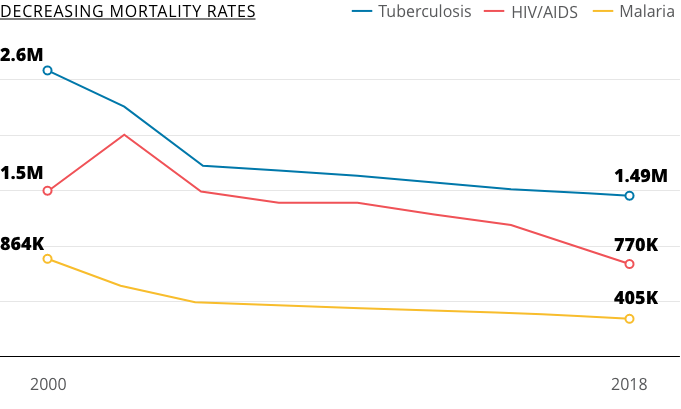These are just some of the many U.S. government investments in global health. In addition, the Global Health Security Agenda, the National Institutes of Health, the Department of Defense and the State Department’s Office of International Health and Biodefense play a crucial role in preparing us for pandemics. Infectious Diseases Rapid Response Reserve Fund, CDC Global Public Health Capacity Programs, CDC Global Disease Detection Program.
Infographic: U.S. AIDS, TB and Malaria Investments and Pandemic Preparedness
How U.S. investments in the global fight to end AIDS, TB and malaria help prepare the world to identify and respond to emerging pandemics.
For over a decade, the U.S. has led the global fight against the world’s deadliest pandemics through programs such as the President’s Emergency Plan for AIDS Relief, the President’s Malaria Initiative, the USAID Tuberculosis program, Gavi and The Global Fund to Fight AIDS, Tuberculosis and Malaria.
The combined efforts of the programs’ services are vital, as they share a common goal of preventing and responding to pandemics.
PROGRAMS


PEPFAR
The Global Fund
President’s Malaria Initiative
USAID Tuberculosis Program
Gavi
(Select a program above to start)
This program fights existing and emerging pandemics through the following services:
SERVICES
These examples show what each slice of the pie looks like when implemented by a program.
Building Health Workforces
e.g., PMI is helping to build a cadre of ministry of health staff with technical skills in the collection, analysis and interpretation of data for decision-making and epidemiologic investigations in 12 focus countries in Africa.
SourceTreat and prevent major existing disease
e.g., PEPFAR leads the U.S. response to the global HIV/AIDS epidemic in more than 50 countries around the world, which is supporting lifesaving HIV treatment for 15.7 million people, has prevented millions of HIV infections, and is accelerating progress toward reaching HIV epidemic control.
SourceDiagnostic and Laboratory Systems
e.g., Uganda’s Supranational Reference Laboratory, funded by the Global Fund, helps 21 countries across Africa conduct complicated TB tests.
SourceSurveillance
e.g., “Nearly 90 percent of PEPFAR-supported countries have implemented, or are planning to implement, HIV case-based surveillance to systematically report newly diagnosed HIV cases.”
SourceSupply Chains
e.g., The Global Fund works with new and existing suppliers to introduce better formulations, meet supply needs around the world and overcome geographic supply risks.
SourceData Systems
e.g., The Global Fund works with new and existing suppliers to introduce better formulations, meet supply needs around the world and overcome geographic supply risks.
SourceTraining Field Epidemiologists
e.g., To sharply decrease the burden of malaria in sub-Saharan Africa and contain multidrug resistance in the Greater Mekong region, PMI supports training through field epidemiology training programs to develop graduates with expertise in malaria prevention, control, surveillance and program evaluation.
SourceImproving Health Systems and Infrastructure
e.g., USAID worked with local officials in Afghanistan to improve TB infection control practices in health care facilities and community settings. This included expanding effective infection control measures to 185 health facilities across all 15 provinces, redesigning infection control systems in 45 health facilities and training 250 health workers in infection control — strengthening the overall health system to protect critical health care workers.
SourceStrategic Planning
e.g., The Global Fund publishes a multi-year road map to set priorities for how the Global Fund partnership can accelerate progress against HIV, TB and malaria and improve global health, including setting ambitious goals and targets to measure progress.
SourceWhy is this investment so vital?
These global investments have achieved dramatic progress against pandemics that kill millions of people each year and help prepare countries to identify and respond to emerging pandemics, too.
In order to realize gains in specific diseases, U.S. global health investments help train local healthcare professionals and build stronger medical supply chains, laboratories, healthcare facilities, data management systems and other areas of health care systems that are also vital to pandemic response.

